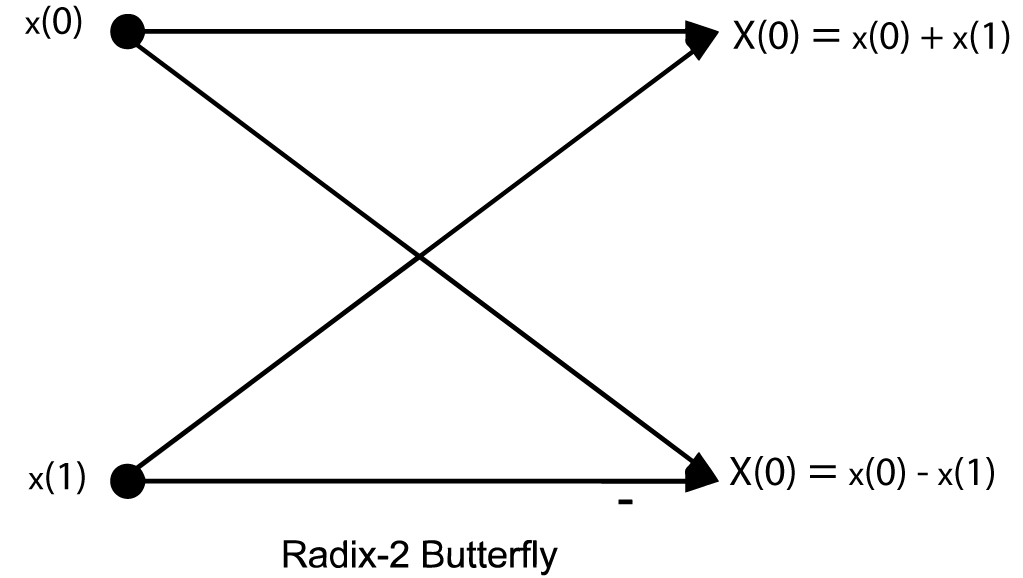The publication by Cooley and Tukey 5 in 1965 of an
efficient algorithm for the calculation of the DFT was a major
turning point in the development of digital signal processing.
During the five or so years that followed, various extensions and
modifications were made to the original algorithm 4. By the early
1970's the practical programs were basically in the form used today.
The standard development presented in 21, 22, 2 shows
how the DFT of a length-N sequence can be simply calculated from the
two length-N/2 DFT's of the even index terms and the odd index
terms. This is then applied to the two half-length DFT's to give
four quarter-length DFT's, and repeated until N scalars are left
which are the DFT values. Because of alternately taking the even and
odd index terms, two forms of the resulting programs are called
decimation-in-time and decimation-in-frequency. For a length of
2M, the dividing process is repeated M=log2N times and
requires N multiplications each time. This gives the famous
formula for the computational complexity of the FFT of Nlog2N
which was derived in Multidimensional Index Mapping: Equation 34.
Although the decimation methods are straightforward and easy
to understand, they do not generalize well. For that reason it will
be assumed that the reader is familiar with that description and
this chapter will develop the FFT using the index map from Multidimensional Index Mapping.
The Cooley-Tukey FFT always uses the Type 2 index map from
Multidimensional Index Mapping: Equation 11. This is necessary for the most popular forms that
have N=RM, but is also used even when the factors are
relatively prime and a Type 1 map could be used. The time and
frequency maps from Multidimensional Index Mapping: Equation 6 and Multidimensional Index Mapping: Equation 12 are
Type-2 conditions Multidimensional Index Mapping: Equation 8 and Multidimensional Index Mapping: Equation 11 become
and
The row and column calculations in Multidimensional Index Mapping: Equation 15 are uncoupled by
Multidimensional Index Mapping: Equation 16 which for this case are
To make each short sum a DFT, the Ki must satisfy
In order to have the smallest values for
Ki the constants in Equation 9.3 are chosen to be
(9.7)
a
=
d
=
K2
=
K3
=
1
which makes the index maps of Equation 9.1 become
(9.8)
n
=
N2n1
+
n2
(9.9)
k
=
k1
+
N1k2
These index maps are all evaluated modulo N, but in Equation 9.8, explicit reduction is not necessary since
n never exceeds N. The reduction notation will be omitted for
clarity. From Multidimensional Index Mapping: Equation 15 and example Multidimensional Index Mapping: Equation 19, the DFT is
This map of Equation 9.8 and the form of the DFT in Equation 9.10 are
the fundamentals of the Cooley-Tukey FFT.
The order of the summations using the Type 2 map in Equation 9.10
cannot be reversed as it can with the Type-1 map. This is because
of the WN terms, the twiddle factors.
Turning Equation 9.10 into an efficient program requires some care.
From Multidimensional Index Mapping: Efficiencies Resulting from Index Mapping with the DFT we know that all the factors should be
equal. If
N=RM ,
with R called the radix,
N1
is first set
equal to
R
and
N2
is then necessarily RM–1.
Consider
n1
to be the index along the rows and n2 along the columns. The inner
sum of Equation 9.10 over n1 represents a length-N1 DFT for each value
of n2. These N2 length-N1 DFT's are the DFT's of the rows
of the  array. The resulting array of row DFT's is
multiplied by an array of twiddle factors which are the WN terms
in Equation 9.10. The twiddle-factor array for a length-8 radix-2 FFT
is
array. The resulting array of row DFT's is
multiplied by an array of twiddle factors which are the WN terms
in Equation 9.10. The twiddle-factor array for a length-8 radix-2 FFT
is
The twiddle factor array will always have unity in the first row and
first column.
To complete Equation 9.10 at this point, after the row DFT's are
multiplied by the TF array, the N1 length-N2 DFT's of the
columns are calculated. However, since the columns DFT's are of
length
RM–1,
they can be posed as a
RM–2 by R array and the
process repeated, again using length-R DFT's. After M stages of
length-R DFT's with TF multiplications interleaved, the DFT is
complete. The flow graph of a length-2 DFT is given in Figure 1 and
is called a butterfly because of its shape. The flow graph of the
complete length-8 radix-2 FFT is shown in Figure 2 .
This flow-graph, the twiddle factor map of Equation 9.11, and the
basic equation Equation 9.10 should be completely understood before
going further.
A very efficient indexing scheme has evolved over the years
that results in a compact and efficient computer program. A FORTRAN
program is given below that implements the radix-2 FFT. It should be
studied 1 to see how it implements Equation 9.10 and the
flow-graph representation.
N2 = N
DO 10 K = 1, M
N1 = N2
N2 = N2/2
E = 6.28318/N1
A = 0
DO 20 J = 1, N2
C = COS (A)
S =-SIN (A)
A = J*E
DO 30 I = J, N, N1
L = I + N2
XT = X(I) - X(L)
X(I) = X(I) + X(L)
YT = Y(I) - Y(L)
Y(I) = Y(I) + Y(L)
X(L) = XT*C - YT*S
Y(L) = XT*S + YT*C
30 CONTINUE
20 CONTINUE
10 CONTINUE
A Radix-2 Cooley-Tukey FFT Program
This discussion, the flow graph of Winograd’s Short DFT Algorithms: Figure 2 and the program
of screen are all based on the input index map of
Multidimensional Index Mapping: Equation 6 and Equation 9.1 and the calculations are performed
in-place. According to Multidimensional Index Mapping: In-Place Calculation of the DFT and Scrambling, this means the output is
scrambled in bit-reversed order and should be followed by an
unscrambler to give the DFT in proper order. This formulation is
called a decimation-in-frequency FFT 21, 22, 2. A very
similar algorithm based on the output index map can be derived which
is called a decimation-in-time FFT. Examples of FFT programs are
found in 1 and in the Appendix of this book.
Modifications to the Basic Cooley-Tukey FFT
Soon after the paper by Cooley and Tukey, there were
improvements and extensions made. One very important discovery was
the improvement in efficiency by using a larger radix of 4, 8 or
even 16. For example, just as for the radix-2 butterfly, there are
no multiplications required for a length-4 DFT, and therefore, a
radix-4 FFT would have only twiddle factor multiplications. Because
there are half as many stages in a radix-4 FFT, there would be half
as many multiplications as in a radix-2 FFT. In practice, because
some of the multiplications are by unity, the improvement is not by
a factor of two, but it is significant. A radix-4 FFT is easily
developed from the basic radix-2 structure by replacing the length-2
butterfly by a length-4 butterfly and making a few other
modifications. Programs can be found in 1 and operation
counts will be given in "Evaluation of the Cooley-Tukey FFT Algorithms".
Increasing the radix to 8 gives some improvement but not as
much as from 2 to 4. Increasing it to 16 is theoretically promising
but the small decrease in multiplications is somewhat offset by an
increase in additions and the program becomes rather long. Other
radices are not attractive because they generally require a
substantial number of multiplications and additions in the
butterflies.
The second method of reducing arithmetic is to remove the
unnecessary TF multiplications by plus or minus unity or by plus or
minus the square root of minus one. This occurs when the exponent of
WN is zero or a multiple of N/4. A reduction of additions as
well as multiplications is achieved by removing these extraneous
complex multiplications since a complex multiplication requires at
least two real additions. In a program, this reduction is usually
achieved by having special butterflies for the cases where the TF is
one or j. As many as four special butterflies may be necessary to
remove all unnecessary arithmetic, but in many cases there will be
no practical improvement above two or three.
In addition to removing multiplications by one or j, there
can be a reduction in multiplications by using a special butterfly
for TFs with WN/8, which have equal real and imaginary parts.
Also, for computers or hardware with multiplication considerably
slower than addition, it is desirable to use an algorithm for
complex multiplication that requires three multiplications and three
additions rather than the conventional four multiplications and two
additions. Note that this gives no reduction in the total number of
arithmetic operations, but does give a trade of multiplications for
additions. This is one reason not to use complex data types in
programs but to explicitly program complex arithmetic.
A time-consuming and unnecessary part of the execution of a
FFT program is the calculation of the sine and cosine terms which
are the real and imaginary parts of the TFs. There are basically
three approaches to obtaining the sine and cosine values. They can
be calculated as needed which is what is done in the sample program
above. One value per stage can be calculated and the others
recursively calculated from those. That method is fast but suffers
from accumulated round-off errors. The fastest method is to fetch
precalculated values from a stored table. This has the disadvantage
of requiring considerable memory space.
If all the N DFT values are not needed, special forms of the
FFT can be developed using a process called pruning 17
which removes the operations concerned with the unneeded outputs.
Special algorithms are possible for cases with real data or
with symmetric data 6. The decimation-in-time algorithm
can be easily modified to transform real data and save half the
arithmetic required for complex data 27. There are
numerous other modifications to deal with special hardware
considerations such as an array processor or a special
microprocessor such as the Texas Instruments TMS320. Examples of
programs that deal with some of these items can be found in
22, 1, 6.
The Split-Radix FFT Algorithm
Recently several papers 18, 7, 28, 23, 8
have been published on algorithms to calculate a length-2M DFT
more efficiently than a Cooley-Tukey FFT of any radix. They all have
the same computational complexity and are optimal for lengths up
through 16 and until recently was thought to give the best total add-multiply count
possible for any power-of-two length. Yavne published an algorithm
with the same computational complexity in 1968 29, but it
went largely unnoticed. Johnson and Frigo have recently reported the first
improvement in almost 40 years 15. The reduction
in total operations is only a few percent, but it is a reduction.
The basic idea behind the split-radix FFT (SRFFT) as derived
by Duhamel and Hollmann 7, 8 is the application of a
radix-2 index map to the even-indexed terms and a radix-4 map to the
odd- indexed terms. The basic definition of the DFT
with W=e–j2π/N gives
for the even index terms, and
and
for the odd index terms. This results in
an L-shaped “butterfly" shown in Figure 9.3 which relates a length-N
DFT to one length-N/2 DFT and two length-N/4 DFT's with twiddle
factors. Repeating this process for the half and quarter length
DFT's until scalars result gives the SRFFT algorithm in much the
same way the decimation-in-frequency radix-2 Cooley-Tukey FFT is
derived 21, 22, 2. The resulting flow graph for the
algorithm calculated in place looks like a radix-2 FFT except for
the location of the twiddle factors. Indeed, it is the location of
the twiddle factors that makes this algorithm use less arithmetic.
The L- shaped SRFFT butterfly Figure 9.3 advances the calculation of the top
half by one of the M stages while the lower half, like a radix-4
butterfly, calculates two stages at once. This is illustrated for N=8 in Figure 9.4.
Unlike the fixed radix, mixed radix or variable radix
Cooley-Tukey FFT or even the prime factor algorithm or Winograd
Fourier transform algorithm , the Split-Radix FFT does not progress
completely stage by stage, or, in terms of indices, does not
complete each nested sum in order. This is perhaps better seen from
the polynomial formulation of Martens 18. Because of
this, the indexing is somewhat more complicated than the
conventional Cooley-Tukey program.
A FORTRAN program is given below which implements the basic
decimation-in-frequency split-radix FFT algorithm. The indexing
scheme 23 of this program gives a structure very similar
to the Cooley-Tukey programs in 1 and allows the same
modifications and improvements such as decimation-in-time, multiple
butterflies, table look-up of sine and cosine values, three real per
complex multiply methods, and real data versions
8, 27.
SUBROUTINE FFT(X,Y,N,M)
N2 = 2*N
DO 10 K = 1, M-1
N2 = N2/2
N4 = N2/4
E = 6.283185307179586/N2
A = 0
DO 20 J = 1, N4
A3 = 3*A
CC1 = COS(A)
SS1 = SIN(A)
CC3 = COS(A3)
SS3 = SIN(A3)
A = J*E
IS = J
ID = 2*N2
40 DO 30 I0 = IS, N-1, ID
I1 = I0 + N4
I2 = I1 + N4
I3 = I2 + N4
R1 = X(I0) - X(I2)
X(I0) = X(I0) + X(I2)
R2 = X(I1) - X(I3)
X(I1) = X(I1) + X(I3)
S1 = Y(I0) - Y(I2)
Y(I0) = Y(I0) + Y(I2)
S2 = Y(I1) - Y(I3)
Y(I1) = Y(I1) + Y(I3)
S3 = R1 - S2
R1 = R1 + S2
S2 = R2 - S1
R2 = R2 + S1
X(I2) = R1*CC1 - S2*SS1
Y(I2) =-S2*CC1 - R1*SS1
X(I3) = S3*CC3 + R2*SS3
Y(I3) = R2*CC3 - S3*SS3
30 CONTINUE
IS = 2*ID - N2 + J
ID = 4*ID
IF (IS.LT.N) GOTO 40
20 CONTINUE
10 CONTINUE
IS = 1
ID = 4
50 DO 60 I0 = IS, N, ID
I1 = I0 + 1
R1 = X(I0)
X(I0) = R1 + X(I1)
X(I1) = R1 - X(I1)
R1 = Y(I0)
Y(I0) = R1 + Y(I1)
60 Y(I1) = R1 - Y(I1)
IS = 2*ID - 1
ID = 4*ID
IF (IS.LT.N) GOTO 50
Split-Radix FFT FORTRAN Subroutine
As was done for the other decimation-in-frequency
algorithms, the input index map is used and the calculations are
done in place resulting in the output being in bit-rever




















